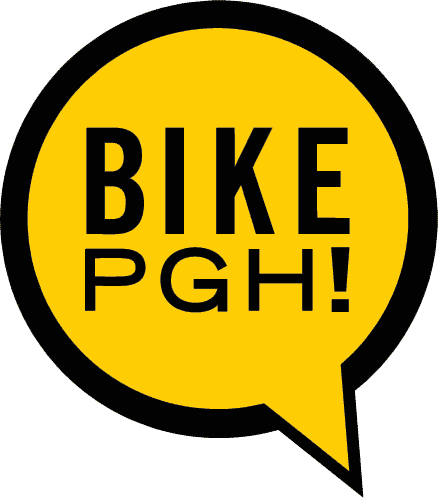Brosville confounds me too but it sure feels good getting to the top.
"on-street bike routes"
I've been going back over the latest bike map and I find myself wondering - what determines whether a street is considered an "on-street bike route"? For some streets it seems to be obvious (bike lanes or sharrows, wide shoulders) but others are head-scratchers (Brosville, the upper portion of Warrington). Can anyone provide any insight?
the "on street" bike routes. Before the map existed, the City of Pittsburgh had the "official" bike route of the city.
it was very outdated. When we (bikepgh) decided to make the bike map, we used the city's route system, and then went over it with a fine tooth comb, cut redundancies, added needed connections (like say stanton ave), etc. we then had local neighborhood volunteers go out and ride these routes and offer suggestions, edits, etc. often we'd go out ourselves and check on these suggestions. with that all said, there are most likely some streets that don't make sense and your local knowledge is appreciated for future iterations. admittedly, we're all very east end centric in the office.
as far as the lanes on there. the "network" was created before any real bike lanes existed. well really only beechwood existed, but you'd be hard pressed to find anyone that called that a bike lane. The City then accepted our routes as the "official network" and are now using the map to inform where bike lanes/sharrows, signs, etc should go.
hope that helps. what do you suggest be done with brosville?
Instead of taking Brosville from the Flats to Allentown(Warrington), take 18th street then this http://g.co/maps/ukcp5 18th->Monastery->St.Martin->Brosville->Warrington
It's an easier grade than the bottom of Brosville, and an alternate St. Thomas to Warrington route.
Before we had automobiles, we had horses and buggies. Horses pulled carts, and often those carts were loaded with a quarter ton of milk, potatoes, whatever. The routes those critters had to use would have been developed out of necessity.
Today, we cyclists would do well to figure out who went where back then, via which routes, and make those the bike routes. The southern third of the city needs a LOT of attention. Like Erok said, the East End has gotten the attention, but that's because it's comparatively flat.
So, how *would* you get into the South Side Flats from, say, Brookline? Or would you? Is there any point? Should you even try? In 1890, would anyone have bothered? I don't know. But this is where the study needs to be.
Stu, didn’t we use to have a dozen or more inclines in the late 1800's - those horses weren’t dumb.
As an aside, my friend’s father use to drive a team delivering barrels of beer to the slopes on the South Side back in the 30’s or 40’s. They use to do a wiggle to get up the slopes, and they didn’t hit too many stops in a day compared to contemporary standards. I remember some of his stories, but I really wish I would have written them down while he was still alive.
Those inclines disappeared not all that long ago. The one near Brosville stopped around 1960, when all the other bus and trolley companies were folded into what is now PAT. The Penn Incline, connecting the Hill District and the Strip, ran as late as the 1950s. The Castle Shannon Incline, on the south side of Mount Washington, ran until 1964. But most were put there in the last quarter of the 1800s, when Pittsburgh got its big population influx. The roads, railroads and the trolley lines laid down then would be what we need to use today for bicycle routes, whether exclusive paths or stripes on pavement.
The early 1900s also marked the building of a lot of our staircase streets. I've commented elsewhere that they're a great alternative to climbing steep streets.
Im new to most of this what is a staircase street?
Well there's this site.
And this book.
Though I always liked Ernie Pyle's take on this whole conversation.
The alternate route sloaps suggests sounds pretty darn good to me. Though that merge back on to Brosville at the end can be tricky during rush hour.
At least one of the current problems with Brosville is temporary - the amount of uphill traffic has increased since the closure of the lower McArdle, and passing there is damn dangerous due to the terrible sightlines. If the McArdle ever reopens this will be less of an issue.
Stu, your suggestion works for places that had populations and travel in the pre-car era. Places that bloomed from 1950-1970, when the personal car was absolute king, mean that pavement is not necessarily placed in places that make any sense. Like Penn Hills, Plum, Monroeville. But these are not the city, these are just my personal stomping (and thrashing and cursing) grounds.
I think the answer to the original question is key - the current system, which is better than any system that came before it but could also be improved, came about because some energetic people got together, figured it out, and convinced "officials" to take the results seriously.
As a kid I was taught proper respect for authority, that signs and maps were handed down by infallible beings and permanently marked the only way the world could possibly work without Total Societal Collapse. As an adult, the fluidity and fickle nature of signs and maps just seems to become less and less concrete. The first time that googlemaps took a suggestion of mine I simultaneously felt like I'd flexed a new god-like power and the horrible realization that this divinity was perhaps not such a high standard after all.
Love Ernie Pyle. That column is fantastic, thanks for sharing...
